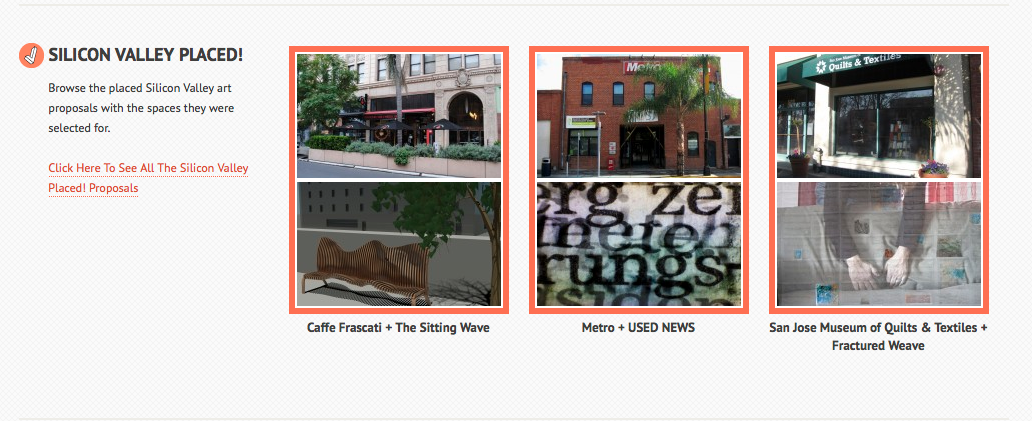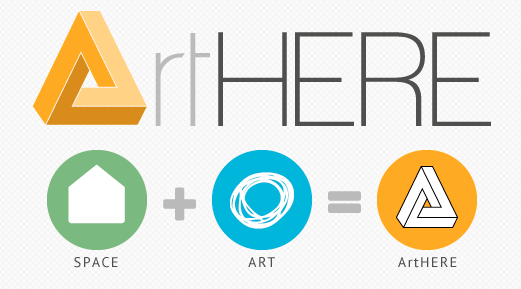| When San Francisco's head of Public Works came to the 2011 Urban Prototyping event, The Summer of Smart he made an interesting observation: "Wherever I see graffiti, I don't see public art and wherever I see public art, I don't see graffiti". For the participants at the event, this was easily fixed. All they had to do was create a 'dating app'! It would match building owners who had blank walls with artists in the local area, thereby cutting down on graffiti and promoting public art. With this simple premise, a small team set about to create a web platform named 'Art Here'. Over one weekend they perfected their pitch and ended up being one of the five winning projects at the Summer of Smart. It could have all stopped there, but with help from Gray Area Foundation for the Arts (GAFFTA) the group developed their idea, made an alliance with the non-profit Art and Technology Network Zero1 and have used their platform to launch art projects in Silicon Valley and San Jose. Now, San Francisco projects are in the pipeline. One of the biggest problems with the Art Here concept was permitting. It was difficult for artists that used traditional mediums (namely paint) to get permission from the city to design and execute a public mural. For the moment, Art Here is getting around restrictions by nurturing relationships with artists and community innovators who use more ephemeral techniques - sound, visualizations, projections and temporary installations. Art Here projects include a conversion of an unused shopfront into a temporary yoga studio, an augmented reality art piece on the lawns of the Palo Alto Arts commission and a digitally fabricated sculpture for the 'Liquid Agency'. Post by Christine Outram > Read the article in Fast Co Exist > www.arthere.org |
|
How do you take a part of town that's struggling and jump-start economic activity, foot traffic and utilize boarded-up space? How do you take a part of town that seems un-loved and show how vibrant and exciting it might be?
An innovative approach to this challenge is SQFT (Pronounced "Square Foot"), one of the winning projects to emerge from Creative Currency, a civic incubation program spearheaded by Gray Area Foundation for the Arts, The HUB, The San Francisco Mayor's innovation office and American Express. SQFT developed a platform to rent temporary space that otherwise would go unused. It makes a market between landlords and entrepreneurs / community members who want to create "pop-up" businesses. Then, using social media techniques it brings these merchants together and promotes their businesses, helping to drive traffic to these newly enlivened neighborhood projects. Local labor is hired and the process is repeated, accelerating development of a neighborhood and allowing merchants and landlords to prototype how a more vibrant neighborhood would work. The project was first tested in San Francisco on August 1st, 2012 and featured five "pop-up" activities including a sidewalk library, a clothing store, free bike repair, a chess club, games night and yoga class. The team that created SQFT first came together at the Creative Currency Hackathon where the idea was hatched and went on to win $3750 in incubation funding. A few months later the project was prototyped in San Francisco's Mid-Market neighborhood. The results demonstrated that foot traffic increased several fold, and that projects were an economic success for participants, landlords and businesses. It is now being scaled up as a resource for multiple cities to draw on. Key to the project's success was the experience of its team members. Events like Creative Currency draw together coders, designers, urbanists, real-estate developers, city officials, and experts on urban problems. Such a rich experience base seldom has a chance to brainstorm new projects, much less compete to test them out on the canvas that is a city. The SQFT team included Emily Eienhart, an urban planning professional and anthropologist from IDEO, Patrick Keenan a software developer with experience in both startups and social innovation activities, and User Experience designer. The team was paired with community mentors including real-estate developer Brian De Lowe from Viceroy Hotels which has a property in the neighbor and participated as a pop-up space host and Bay Area Hub Board President Penelope Douglas. So often we look at a blighted neighborhood and think, "That's blight. It'll never change." By prototyping what vibrant neighborhood activity looks like, SQFT demonstrates what's possible and helps to overcome the predisposition and imagination gap we often bring to challenged neighborhoods . Post by Peter Hirshberg More information: > Article in Forbes > Article by Shareable
|



 RSS Feed
RSS Feed
